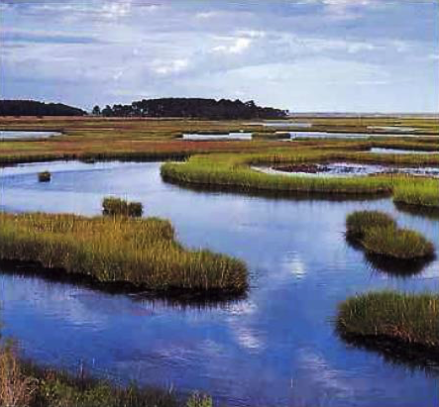Experiments
#2 COMPARISON OF CARBON SEQUESTRATION IN SALTWATER MARSHES VERSUS TREES
Carbon Sequestration in Tidal Salt Marshes
An extension can be made to the tree carbon capture experiment by comparing trees with the carbon sequestration in coastal marsh lands that are very commonly found along the shores of New England. In addition to their many other benefits (such as habitats for birds and a diversity of sea life such as crabs, shrimp, and mussels, and flood mitigation) saltwater marshes are very good absorbers of CO2 from the atmosphere as long as they are constantly being refreshed by salty ocean water as tides flow in and out. In fact, saltwater marshes may be more effective than trees for sequestering carbon.
Considerable research has been conducted on this topic which can be summarized by the picture below that shows that carbon is absorbed in underground pools as illustrated by the downward green arrow and the brown area on the right indicating “Soil C.” (Kroeger, Kevin D. , et. al, “Restoring Tides to Reduce Methane Emissions in Impounded Wetlands: A new and Potent Blue Carbon Climate Change Intervention, Nature, Volume 7, September 20, 2017, Figure 2. https://www.nature.com/articles/s41598-017-12138-4 )
The marsh grasses and plants are absorbing sunlight and conducting photosynthesis just as trees do which captures CO2. Wetlands are also great at storing CO2 because they are nearly always covered by water therefor preventing oxygen from entering the muddy water effectively keeping in check bacterial decomposition a process that releases a little CO2 as depicted by the smaller upward green arrow.
Marshes also produce methane or CH4 as grasses and plants die and decompose (see small upward orange arrow in diagram.) One of the benefits, however, of saltwater marshes, in contrast to fresh-water marshes, is that seawater contains sulfate ions which inhibit methane emissions while allowing the high rates of net CO2 intake. Thus, on net, saltwater marshes are very effective at carbon sequestration. Sea grasses have similar properties as salt marshes, and mangrove forests (which are not that common around New England but found in coastal waters in Florida, Caribbean and elsewhere) are similar to salt marshes in their ability to absorb and sequester carbon from the atmosphere.
How do saltwater marshes compare with our calculations above for red oak trees? One way of comparing is to use our Emission Factors and emissions from a typical passenger vehicle driven in one year. These calculations are shown in Table 1 and comparisons shown in the bar graph below. Whereas it takes 1.3 acres of white pines to off-set vehicle emissions, with Saltwater Marshes having an average Emission Factor of 0.041 it requires about the same -- 1.5 acres. If the emission factor is near the high end of what has been reported (e.g., -0.409 pounds C ft-2 y -1 ) it requires only two tenths of an acre. At the other extreme with an EF of -0.022 pounds C ft-2 y -1 reported in the IPCC report the acreage increases to 2.8 acres or twice as much as white pine forest.
Students living in coastal regions around the US are encouraged to visit convenient beaches to explore and photograph saltwater marsh lands and participate in efforts to protect these valuable regions for helping address climate change. In the Northeast U.S. The Trustees have a Youth Coastal Ambassador’s Program (YCAP) to help teens learn about coastal landscapes and restoration including beach profiling, salt marsh cleanups, and dune restoration. (Students are encouraged to sign up at volunteer.thetrustees.org)
CONCLUSION: Saltwater marsh lands along coastal regions of the US are a very effective natural resource comparable or exceeding white pine trees for sequestration of CO2. on an area basis.
TABLE 1 – Worksheet for Calculating Carbon Sequestration in Tidal Saltwater Marshes






